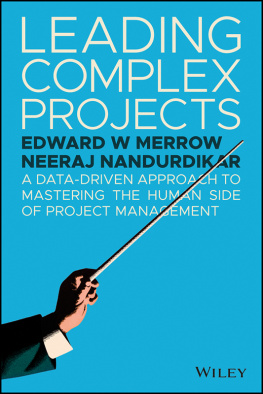Business Leadership for IT Projects
For Odette
Business Leadership for IT Projects
GARY LLOYD

First published 2013 by Gower Publishing
Published 2016 by Routledge
2 Park Square, Milton Park, Abingdon, Oxon OX14 4RN
711 Third Avenue, New York, NY 10017, USA
Routledge is an imprint of the Taylor & Francis Group, an informa business
Copyright Gary Lloyd 2013
All rights reserved. No part of this book may be reprinted or reproduced or utilised in any form or by any electronic, mechanical, or other means, now known or hereafter invented, including photocopying and recording, or in any information storage or retrieval system, without permission in writing from the publishers.
Notice:
Product or corporate names may be trademarks or registered trademarks, and are used only for identification and explanation without intent to infringe.
Gary Lloyd has asserted his moral right under the Copyright, Designs and Patents Act, 1988, to be identified as the author of this work.
British Library Cataloguing in Publication Data
A catalogue record for this book is available from the British Library
Library of Congress Cataloging-in-Publication Data
Lloyd, Gary.
Business leadership for IT projects / by Gary Lloyd.
pages cm
Includes bibliographical references and index.
ISBN 978-1-4094-5690-2 (hbk)
1. Information technology--Management. 2. Information technology projects--Management. I. Title.
HD30.2.L66 2014
004.0684--dc23
2013006120
ISBN 978 1 4094 5690 2 (hbk)
Contents
List of Figures
List of Tables
About the Author
Gary Lloyd is a programme and project management specialist who helps organisations and individuals to deliver value from their projects and programmes through: consultancy, mentoring, coaching, training and project assurance. His aim is to work with clients to both lower project risk and to develop organisational and individual delivery capability.
He has been helping businesses to deliver IT enabled change for over 20 years. His roles have ranged from being the business leader who drives the change, through to being a trusted advisor to CEOs and COOs, helping them to get value from their projects, programmes and ventures.
Gary has worked across a variety of countries and cultures that include various European countries, Japan, India, Hong Kong and the USA.
Garys website can be found at: www.doubleloopconsulting.com and his blog at blog.doubleloopconsulting.com
Acknowledgements
I want to thank four key people for helping to make this book happen.
First, I want to thank my wife Doris. Without her help and encouragement, this book would never have happened. In addition to her unstinting moral support, she was my primary reviewer and acid test for whether my writing made sense and was useful.
Second, I want to thank my friend Stephen Haxby, who read every single word with an eye that combined a critical evaluation of both the big picture and the fine detail. His encouragement gave me the confidence that I could write passably well and had written some useful things. High praise indeed.
Third, I want to thank my friend Mark Alderton, who, through our conversations, provided much of the inspiration for this book. Marks reviews provided invaluable commentaries on the topics that I wrote about. Many of his ideas found their way into the book.
Finally, I want to thank my commissioning editor, Jonathan Norman, who saw potential in my original proposal and whose enthusiasm lit the touch-paper to complete the project.
Introduction
The track record of IT projects is poor. Less than a third of IT projects deliver what they said they would, on schedule and on budget. Getting value from IT projects is therefore dependent on business managers stepping up to the plate and taking responsibility to lead.
IT people receive substantial amounts of training that is designed to help them to deliver successful projects. That training includes technical, project management and interpersonal skills, and it is usually set within the context of project definition and delivery. Contrast this with the average business manager, who rarely gets any training in how to deliver projects, let alone the special case which is an IT project.
There seems to be an implicit assumption that a business manager who has reached management level should somehow know what do when confronted with an IT project as if it were an innate skill. Its a little like expecting someone to sit behind the wheel of a car for the first time and to be able to drive, just because they happen to be an adult. At least in a car, however, the driver will quickly become aware of his or her lack of competence. But in the complex world of IT projects, the results of bad driving may not manifest themselves for many months or years.
This book sets out to redress this shortfall in business management education. My aim is to help business managers deliver value from their IT projects. You might be a project sponsor, within an organisation, who wants to drive forward a change programme. Or you might be a functional line manager who has been nominated as the business representative on an IT project by your boss. Or you might be a business owner. If you fit any of these descriptions, then this book is for you.
If you are a professional project manager, although the book is not directly addressed to you, it will help you to understand the optimum touchpoints that will maximise the return of investment of a project sponsor or business managers time. In other words, when and how best to get your project sponsor involved.
I will describe practical tools that you can use at the various stages of a projects life-cycle. If your project is in progress, you can dip into this book and pick out tools that will help to address weaknesses in your project without having to jettison your existing project approach. If, however, you are about to embark on a new project, the tools will provide you with a coherent framework for business involvement in your IT project. Finally, if your organisation or IT supplier already has a well-defined approach to IT projects, you should find that my suggestions complement these approaches by providing a business-centric view.
When I have mentioned the topic of this book to some IT professionals, they have shaken their heads pityingly and said something like of course you realise that there is no such thing as an IT project?. They are anxious to show that they understand that the delivery of an IT system achieves nothing, unless it is coupled with the achievement of a business outcome. And of course they are right. However, I never hear the same semantic point from business managers. They well understand the challenge of getting value from an IT project. But to avoid doubt about what makes IT projects distinctive, let me offer my definition. You will also find it, and other terms, in the glossary at the back of this book.
WHAT IS AN IT PROJECT?
An IT project is a project that delivers a new or changed capability, based on IT, that delivers business value. The project is not complete until the value is realised or demonstrably on the way to being realised.
Research shows that most IT projects succeed or fail because of people rather than because of technology issues. The vast majority of projects are simply not at the cutting edge of technology. I have therefore described a framework that combines a strong sense of process with a strong sense of people factors. The aim has been to integrate what we know from the study of psychology into the overall approach and tools described, such that the tools address process and people needs simultaneously.
Next page















